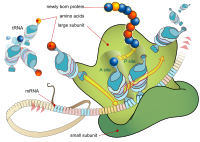
Photo from wikipedia
Finding the start Eukaryotic translation involves many players in a dynamic and well-orchestrated process. A 43S preinitiation complex (PIC) comprises the 40S ribosomal subunit; initiation factors, including the eIF3 complex,… Click to show full abstract
Finding the start Eukaryotic translation involves many players in a dynamic and well-orchestrated process. A 43S preinitiation complex (PIC) comprises the 40S ribosomal subunit; initiation factors, including the eIF3 complex, which is known to play a key role; and the transfer RNA used for translation initiation. The PIC is recruited to the cap-binding complex eIF4F at the 5′ end of messenger RNA (mRNA) to form a 48S complex that scans along the mRNA for a start codon. Brito Querido et al. determined the structure of a reconstituted human 48S complex using cryo–electron microscopy. They found that eIF4F binds to eIF3 near the exit site of the ribosome. This positioning suggests that downstream mRNA is likely pulled through the 40S subunit to find the start codon. Science, this issue p. 1220 A cryo–electron microscopy structure provides insight into how the translational initiation complex scans mRNA to find the start site. A key step in translational initiation is the recruitment of the 43S preinitiation complex by the cap-binding complex [eukaryotic initiation factor 4F (eIF4F)] at the 5′ end of messenger RNA (mRNA) to form the 48S initiation complex (i.e., the 48S). The 48S then scans along the mRNA to locate a start codon. To understand the mechanisms involved, we used cryo–electron microscopy to determine the structure of a reconstituted human 48S. The structure reveals insights into early events of translation initiation complex assembly, as well as how eIF4F interacts with subunits of eIF3 near the mRNA exit channel in the 43S. The location of eIF4F is consistent with a slotting model of mRNA recruitment and suggests that downstream mRNA is unwound at least in part by being “pulled” through the 40S subunit during scanning.
Journal Title: Science
Year Published: 2020
Link to full text (if available)
Share on Social Media: Sign Up to like & get
recommendations!